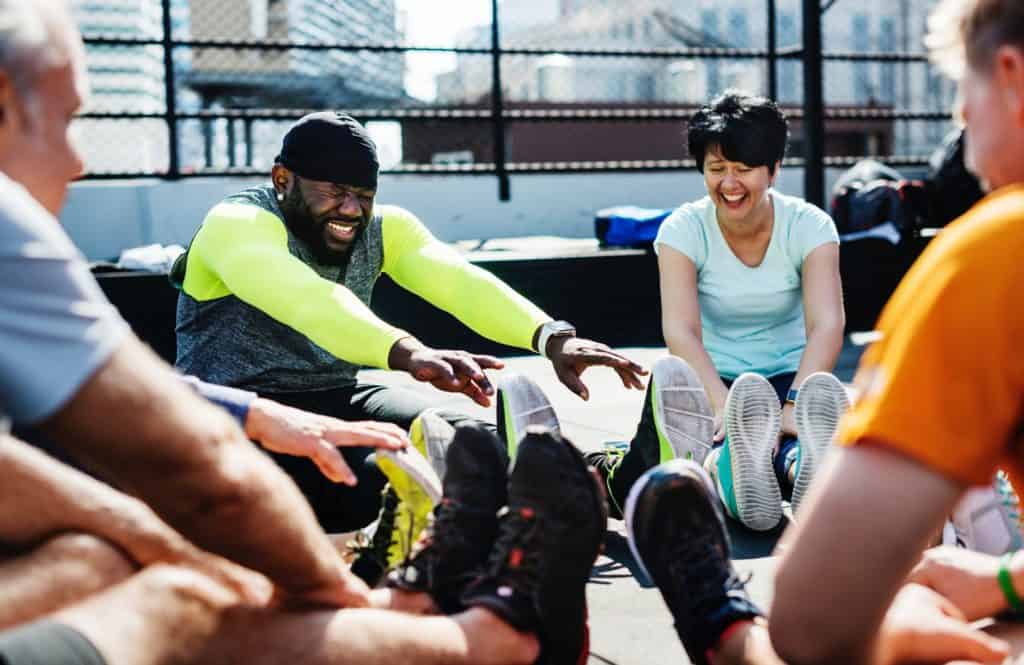Arm Day Aesthetic
Everyone loves arm day. After a few sets of heavy curls, we feel enormous. Our sleeves get tight, our biceps feel like they are about to explode, and veins start popping out everywhere. It’s a huge confidence booster, considering our arms are a huge set of vanity muscles. Think about it, Flex Friday is almost exclusively people showing off their biceps. Strong, defined arms are highly sought after, but most people stop the entire workout when biceps are tired, neglecting the other parts of their arms. Maybe, they don’t realize that a full arm day workout consists of more than just curls?
Your biceps are just one part of your arms, and a smaller part at that. Understanding how your arm is made up, and how best to train it, is essential for growing them into where you want them to be. Strong, well defined arms are essential parts of the human body for lots of reasons, and they are extremely helpful when going about day to day activities.
What Do Arms Do For You?
Our arms are incredibly important to us. They are among the most used parts of our bodies, in terms of how we interact with the world around us. Each arm performs hundreds or thousands of functions each day. They help us push things away, pull things close to us, move ourselves around, and even help us to balance ourselves throughout the day. Life would be incredibly difficult without them.
Strengthening your arms will help you move more efficiently with every day activities, giving you a better quality of life. Powerful arms will make a difference, regardless of what you do. They help when you mow your lawn, shovel snow, bring groceries up the stairs, or carry your sleeping child to their bed.
Anatomy of your Arms
Like every other part of your body, the arms are made up of tons of muscles. When it comes to arms, you have major groups like the biceps and triceps which allow you to bend your elbow, but also the smaller muscles in your forearms and hands that allow you to grip things.
Upper Arm
Your upper arms are made up of 2 main muscle groups, one is anterior (the biceps in the front) and the other is posterior (triceps in the back).
Biceps
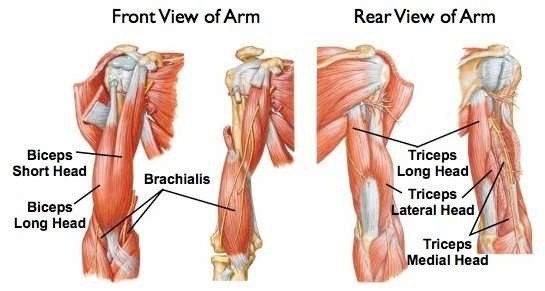
Biceps are interesting. Most people consider their size to be indicative of strength. Human biceps are actually two separate muscles, one originating on the scapula and the other in the shoulder. They both end in the forearm, allowing us to bend our elbow upwards and rotate the forearm.
Need some help?
Shape Success, Live Exceptionally
Hit that button, and get started today.
Triceps
If you thought the biceps were interesting, our triceps are three headed beasts. All three heads converge at the forearm, allowing us to straighten our arms. One head originates from just below the scapula and the other two start on the upper arm itself.
Lower Arms and Hands
No arm day is complete without doing something to strengthen grip. In order to do that you need to exercise the muscles in your forearms, wrists, and hands. To be honest, most of our wrists and hands are just bones and tendons with just a few muscles between the fingers. Working to strengthen grip is mostly just strengthening the forearms, which pull your fingers and move your wrists.
When to Train
Arms are especially important to train, whether you are doing it for vanity reasons or just to help out at work. They are an unavoidable asset that you should aim to maximize.
Your arms are used during pretty much activity you do, including other exercises. Triceps, for example, are used heavily when you train your chest, while your biceps are included in exercises such as rows. They get a good bit of exercise each week when you do other things, but in more of a stabilizer/supporting muscle role. They deserve to be the focus of their own training, however.
Throw an arm day workout into each week that focuses strictly on the muscles you want to develop in them. Think of how your arms move, and pick some warmups/exercises that are similar. If you want to be extra focused on the different parts of your arm, break arm day into two separate workouts,. working different aspects of the arm at different times. You can even tack parts of the workout onto other days, training triceps the same day you do chest, for example.
Warmups
Before each workout,make sure you warm up properly. A good warm up primes your muscles for the work you about to do, increasing the blood flowing around your body, bringing in nutrients, and helping to stretch them out a bit. A good warm up will help reduce the chance of injury.
Jogging, rowing, and jumping rope are some fantastic movements that not only get your heart beat up, but also get your arm muscles ready. Take 5-10 minutes to really get the blood flowing and your heart pumping.
Once you have your heart beat elevated, throw in a few dynamic stretches that target your arms, help with overall range of motion, and get the muscles themselves warmed up. Here are some ideas:
Arm Swings
Arm swings are just fun to do. Waving your arms around in this controlled, but strong motion helps you stimulate your shoulder muscles, and get the blood flowing.
How to do it: Stand upright, bring your arms up to either side, elbows bent, and hold them at shoulder level. Simultaneously, swing both arms inwards, towards your chest. Return to the starting position, and swing again.
Arm Circles
Arm circles help to get the blood flowing all the way down to your hands, while also helping to activate your shoulders and warm up the supporting muscles.
How to do it: Stretch your arms all the way out in front of you. Start to rotate them slowly in as big of a circle as you can. Try reaching to the ceiling, before trying to reach the floor, without moving your torso. After 10 – 12 passes in a circle, change direction and go the other way. These help to get your shoulders loose, and blood flowing from the shoulder to your fingertips.
Bicep Stretch

Bicep stretches will help you to stretch out your muscles, helping to push out any remaining toxins and bring in new nutrients before you start working on them.
How to do it: Sit on the floor with your feet flat and knees bent. Place your palms on the floor behind you with your hands facing away from your body. Hold your hands and arms in place and slowly slide your butt away from your arms until you feel a slight pull and hold.
Tricep Stretch
Stretching out your triceps can really help to activate them, causing them to bring in extra nutrients and blood flow before you use them.
How to do it: How to do it: While standing, reach up and behind your back with your right arm. Try to reach between your shoulder blades. Using your other hand, reach behind your back, and upwards, trying to grasp the opposite hand between your shoulder blades. When you feel a good stretch, hold. If you can’t quite reach, use a towel to make the connection and pull until you feel the stretch.
Workout
Arms are an interesting part of our bodies. One that we don’t always understand completely. Most people focus primarily on biceps, thinking that they are where we should put most of our energy. Our triceps make up 2/3rds of our arms, however, and should get a much bigger block of time and energy than most people give them.
Lots of people also exercise with bad form, swinging their whole bodies instead of using slightly lighter weights; keeping them from focusing on just the motion of the muscles being worked. Bad form can cause injury at worst, or reduce the amount of work the targeted muscles do at best. Less work equals less results, after all, so let’s avoid that.
Pick 3-4 exercises the focus on each muscle in the group, working them slowly and properly. Lots of people tend to move through each arm exercise quickly instead of focusing on the burn that comes from slower contractions. Good tempo is important for growth of any muscle. Take your time while curling or extending each muscle.
Triceps
Dips
Dips are a fantastic way to get your triceps working. They recruit the majority, if not the entirety, of the tricep group, supporting your body as you lower yourself down and then lift yourself back up.
Keep your back straight and your body vertical in order to get a purely tricep experience. Don’t go too wide on the grip, though, or you risk hurting your shoulders. Keep your arms as close to shoulder width apart as possible and tuck your arms, don’t flare your elbows.
How to do it: Using a set of parallel bars, or a dip machine, grasp each bar and hold yourself up, extending your arms, and straightening your elbows. Slowly lower yourself downwards until your elbows are at a 90 degree angle, and then push yourself back up.
Skull Crushers
These are exactly what they sound like. You are bringing the weights down to your face, so make sure that you pick a weight that you can handle or have a partner to watch you as you do these.
How to do it: Laying on a bench, hold a tricep bar straight out above your chest, with your palms facing your feet.Slowly bend at your elbows and bring the weight towards your face. When you have brought the weight down as far as you can, slowly return the weight to the starting position.
Keep your upper arms locked in place, close to your body, and use only your triceps to move the bar, keeping your wrist locked.
Close Grip Press
Close grip bench is a modified flat bench press that targets your triceps instead of your chest. When it comes to the bench press, the wider your grip, the more chest you utilize. In this case we want to target our triceps, so keep your elbows close to your sides, don’t flare your elbows, and push using just your triceps.
How to do it: Close grip bench press is the same as ‘regular’ bench press, the only difference being that you move your hands inwards so they are just a few inches apart, rather than shoulder width. Lower the weights down towards your chest, and push them back up to the starting position once it nearly reaches your chest.
Tricep Push Down
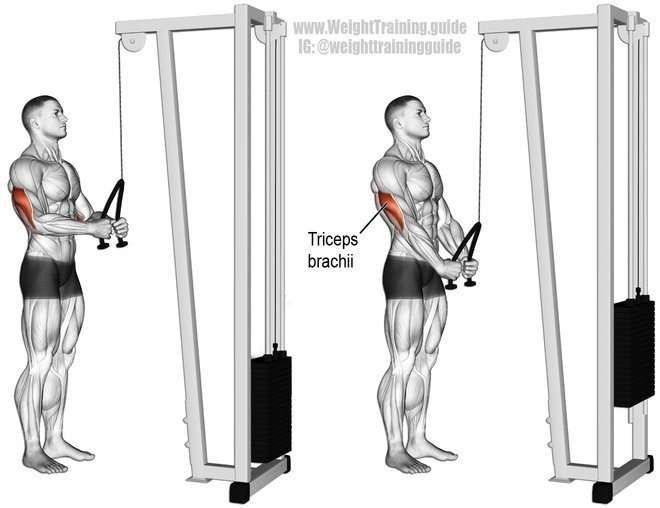
The classic tricep push down. This movement mimics dips in terms of the muscles recruited. Keep your elbows tucked and back straight as you push down to avoid using other muscles.
How to do it: Find a cable machine in your gym and use a split rope attachment. Position the rope at just below eye level, select a weight that you can move with your triceps, and grasp both ends of the rope. Square your feet, and without using the rest of your body, push the rope downwards slowly. Exhale as you push, hold at the bottom for a second, and slowly return your elbows back to a 90 degree angle.
NOTE: For an extra burn, rotate your forearms down and outwards when you get the rope to the bottom of the movement. Hold for a few seconds before returning your forearms back, and slowly bringing the rope back up to the starting position.
Overhead Extensions
When most people do overhead extensions they swing their whole body because they use too much weight. The goal here, like any other tricep (or even bicep) exercise is to lock the rest of your body and only use the muscles you are targeting.
How to do it: Overhead extensions are done on a cable machine and have the same movement as a skullcrusher, just overhead while standing. Find a cable machine with a rope extension. Grasp the rope, face away from the machine, and hold the attachment over head, with your elbows bent. Extend your elbows forward until your arms cannot go any further, and slowly return to the starting position with your elbows at a 90 degree angle overhead.
If you need to, place one foot ahead of the other for stability and lean forward. Lock your upper arms in place and only move at the elbows while you are extending you are extending your arms, keeping your wrists locked. If you find yourself using other muscles, reduce the weight.
Diamond Pushup
Diamond pushups are a favorite of people who like to show off. They are harder than traditional pushups thanks to their smaller footprint. Bringing your hands together forces more of the triceps to be recruited, reducing the workload that your chest does, and increases the difficulty.
How to do it: This is your basic pushup with a twist. Instead of keeping your hands at your sides, shoulder width apart, move your hands together in a diamond shape. Starting from an upwards position, lower yourself down as far as you can, and push back up slowly.
Biceps
Standing Bar Curl
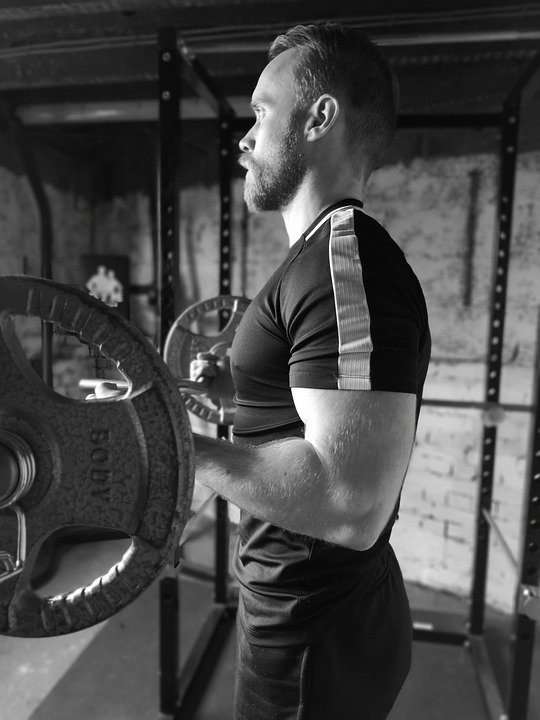
Standing bar curls are a favorite of gym rats and newbies alike. Not surprising, considering it is thought to be a fantastic gauge of strength.
How to do it: With a tricep bar in hand, stand with your feet shoulder width apart, arms hanging, and palms facing outwards. Slowly curl the bar upwards. Once the bicep is fully contracted, pause, and slowly return to the starting position. Be sure not to swing the entire body to move the weight, focusing on just the biceps doing the work.
Just like any of the other exercises here, make sure that you lock the rest of your body. Don’t swing the weight upwards. Control yourself as you curl the bar upwards towards your face, keeping all joints except your elbow locked and stationary. That is how you grow.
Dumbbell Curls
These isolation curls are a great way to really build out your biceps. If you want a large bicep peak, isolating them when you work them is a great place to start.
How to do it: Sit down on a bench or chair and grab a weight that you can curl with one arm. Don’t go so heavy that you cannot lift it without swinging your whole body or using your other arm to assist. While your arm is extended and your elbow is resting on your thigh, right inside the knee, begin to curl the weight upwards. Making sure that your wrists are straight, curl until the your biceps are fully engaged and you cannot curl any more. Slowly, return the weight back to the starting position.
Hammer Curls
Hammer curls are an easy modification of preacher curls, standing bar curls, or even dumbbell curls. The main difference is the muscle they target. Instead of the peaks, they work the width of your biceps.
How to do it: Using the same starting position as either a standing bar curl or preacher curls, rotate your forearm 45 degrees inwards. Slowly, contract your biceps, bringing the weight towards the shoulder. The top of the weight, instead of the middle of the weight, should be pointing towards your shoulder at peak contraction.
Preacher Curls
Bodybuilders and newbies both revere preacher curls. The pad really helps to isolate the biceps and causes them to do all the work, freeing you from the potential of bringing in any other body part.
How to do it: Using a curl station, adjust yourself so that the pad supports the entirety of your arm up to the shoulders. Extend your arm(s) and grasp a weight, bar or dumbbell, with your palms facing upwards. Curl until fully contracted. Slowly return the weight to the starting position.
Forearms
Exercising your forearms helps to strengthen your overall grip and builds your ability to hold heavier weights. You get a ton of exercise in this realm while grasping different weights. Any workout that involves grasping weights with your hands can build up your forearms, but is there more you can do? Yes.
Grip strengtheners are tools you can hold in your hands and squeeze on the go. They come in different weights, and allows you to strengthen your ability to squeeze objects tighter.
If you don’t have those handy, holding a light bar or dumbbell and doing some wrist curls (curling with just your wrist) are good replacements.
Of course, you could always just hold something heavy and do some farmer walks around the gym, putting the weight down when you need to. If the muscles are burning from being tired, they are getting a workout.
Cooldown
As with all workouts, a proper cool down that is full of stretches is very important. Taking some extra time to bring yourself back down from the workout will help you recover properly.
Take 5-10 minutes at the end of each workout to bring yourself down. Perform a few stretches to help lengthen any ligaments and muscles that may have tensed up during the workout, wring out any remaining lactic acid, and generally help return your muscles to a stable environment that is ready for recovery.
Overhead Tricep Stretch
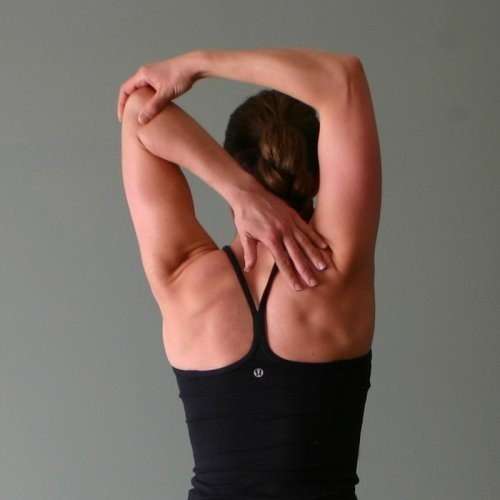
Repeating the same stretch you had prior to working out also helps prime your triceps for recovery. Stretching them afterwards helps to remove toxins and increase blood flow. Getting them set up in an environment for good recovery is a must.
How to do it: While standing, reach up and behind your back with your right arm. Try to reach between your shoulder blades. Using your other hand, reach behind your back, and upwards, trying to grasp the opposite hand between your shoulder blades. When you feel a good stretch, hold. If you can’t quite reach, use a towel to make the connection and pull until you feel the stretch.
Bicep Stretch (again)
Same as with triceps, stretching your biceps after they are exercised will help you to lengthen them muscles; helping to push any remaining toxins away, and bringing in new nutrients to get them set up for recovery.
How to do it: Sit on the floor with your feet flat and knees bent. Place your palms on the floor behind you with your hands facing away from your body. Hold your hands and arms in place and slowly slide your butt away from your arms until you feel a slight pull and hold.
Recovery
As always, it is very important to get enough rest so your muscles can rebuild themselves. Don’t overwork your arms, allowing them to repair the muscle fibers that were hurt during your workout.
Stack proper rest with proper nutrition and hydration, and you have the key to success.
Conclusion
Very few people neglect arm day. A lot of people, however, do not properly exercise the entirety of their arms. Triceps are often neglected in favor of the vanity that come along with biceps. Triceps are far more important, however, and even more impressive when properly developed.
Make sure that you take time at least once a week to really get in a good arm day workout. Make sure that it targets both major groups to their full potential. Throw in adequate rest and stretching, and you will see changes pretty quickly.
Let Us help You Out
At CONDITIONerd we are here to help you achieve better physical and mental health through exercise. Check out the plans we offer to our customers and see if you could benefit from working with our team. And if you have questions, you can always contact a CONDITIONerd team member.
Personal trainers, like those found here, can help guide you on your pathway towards reaching your fitness goals, whether that is getting bigger, stronger, faster, more lean, or just generally feeling better.
We can get you setup with a periodized workout plan, supplement information, and advice on nutrition to help you reach your goals.
The only thing you need is some motivation and a willingness to change some old habits.
Get into contact with us to find out what membership is right for you. In a CONDITIONerd program, you’ll be surrounded by others who can help you to get where you want to be.
Generally, our clients start to see some pretty awesome changes in 2-3 months time, some sooner.

